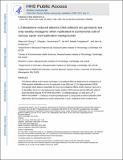1,3-Butadiene-Induced Adenine DNA Adducts Are Genotoxic but Only Weakly Mutagenic When Replicated in Escherichia Coli of Various Repair and Replication Backgrounds
Author(s)
Seneviratne, Uthpala I.; Wu, Jie; Tretyakova, Natalia; Chang, Shiou-chi; Essigmann, John M
Downloadnihms875921.pdf (1.114Mb)
PUBLISHER_POLICY
Publisher Policy
Article is made available in accordance with the publisher's policy and may be subject to US copyright law. Please refer to the publisher's site for terms of use.
Terms of use
Metadata
Show full item recordAbstract
The adverse effects of the human carcinogen 1,3-butadiene (BD) are believed to be mediated by its DNA-reactive metabolites such as 3,4-epoxybut-1-ene (EB) and 1,2,3,4-diepoxybutane (DEB). The specific DNA adducts responsible for toxic and mutagenic effects of BD, however, have yet to be identified. Recent in vitro polymerase bypass studies of BD-induced adenine (BD-dA) adducts show that DEB-induced N⁶,N⁶-DHB-dA (DHB = 2,3-dihydroxybutan-1,4-diyl) and 1,N⁶-γ-HMHP-dA (HMHP = 2-hydroxy-3-hydroxymethylpropan-1,3-diyl) adducts block replicative DNA polymerases but are bypassed by human polymerases η and κ, leading to point mutations and deletions. In contrast, EB-induced N⁶-HB-dA (HB = 2-hydroxy-3-buten-1-yl) does not block DNA synthesis and is nonmutagenic. In the present study, we employed a newly established in vivo lesion-induced mutagenesis/genotoxicity assay via next-generation sequencing to evaluate the in vivo biological consequences of S-N6-HB-dA, R,R-N⁶,N⁶-DHB-dA, S,S-N⁶,N⁶-DHB-dA, and R,S-1,N⁶-γ-HMHP-dA. In addition, the effects of AlkB-mediated direct reversal repair, MutM and MutY catalyzed base excision repair, and DinB translesion synthesis on the BD-dA adducts in bacterial cells were investigated. BD-dA adducts showed the expected inhibition of DNA replication in vivo but were not substantively mutagenic in any of the genetic environments investigated. This result is in contrast with previous in vitro observations and opens the possibility that E. coli repair and bypass systems other than the ones studied here are able to minimize the mutagenic properties of BD-dA adducts.
Date issued
2017-05Department
Massachusetts Institute of Technology. Center for Environmental Health Sciences; Massachusetts Institute of Technology. Department of Biological Engineering; Massachusetts Institute of Technology. Department of ChemistryJournal
Chemical Research in Toxicology
Publisher
American Chemical Society (ACS)
Citation
Chang, Shiou-chi et al. “1,3-Butadiene-Induced Adenine DNA Adducts Are Genotoxic but Only Weakly Mutagenic When Replicated in Escherichia Coli of Various Repair and Replication Backgrounds.” Chemical Research in Toxicology 30, 5 (April 2017): 1230–1239 © 2017 American Chemical Society
Version: Author's final manuscript
ISSN
0893-228X
1520-5010